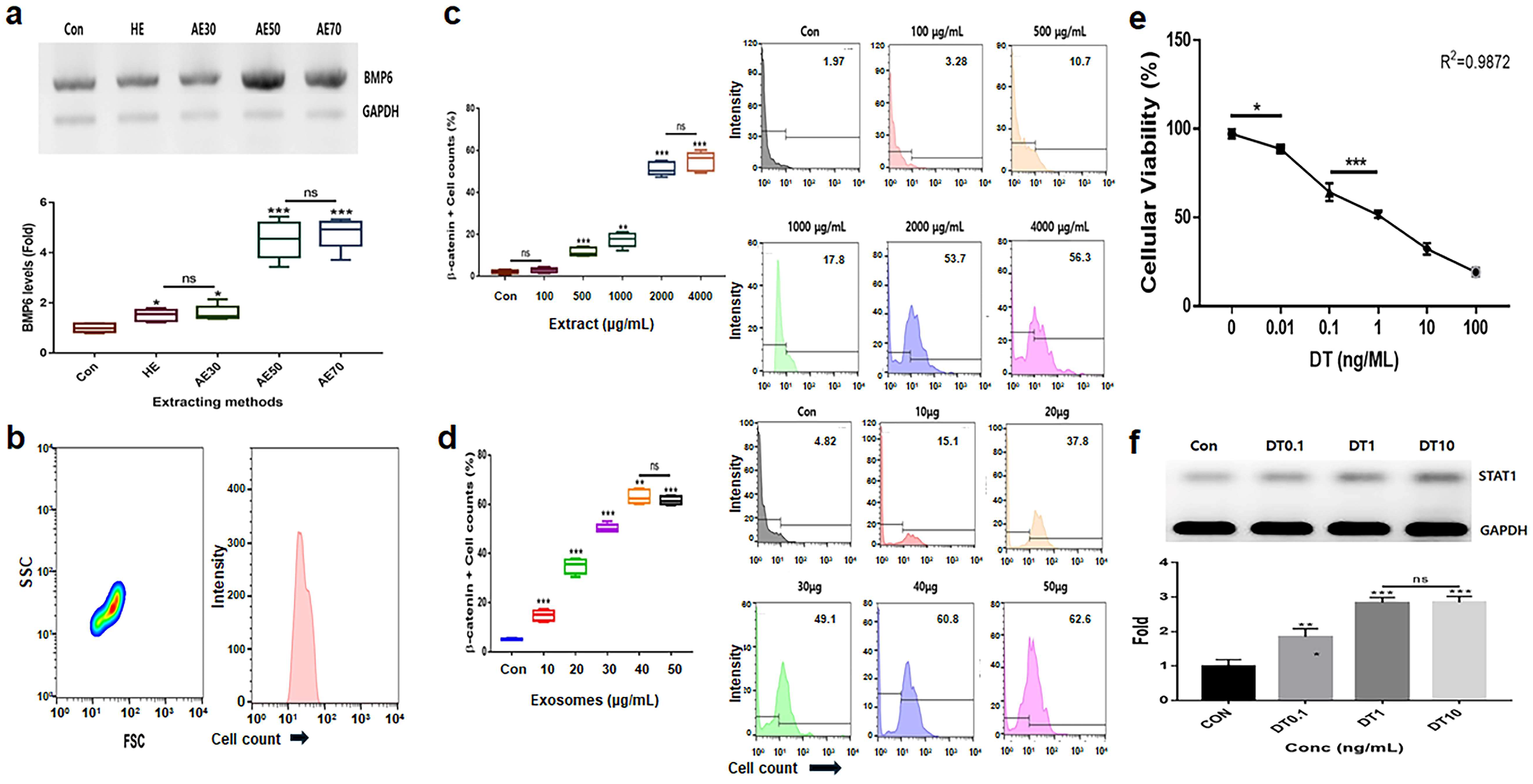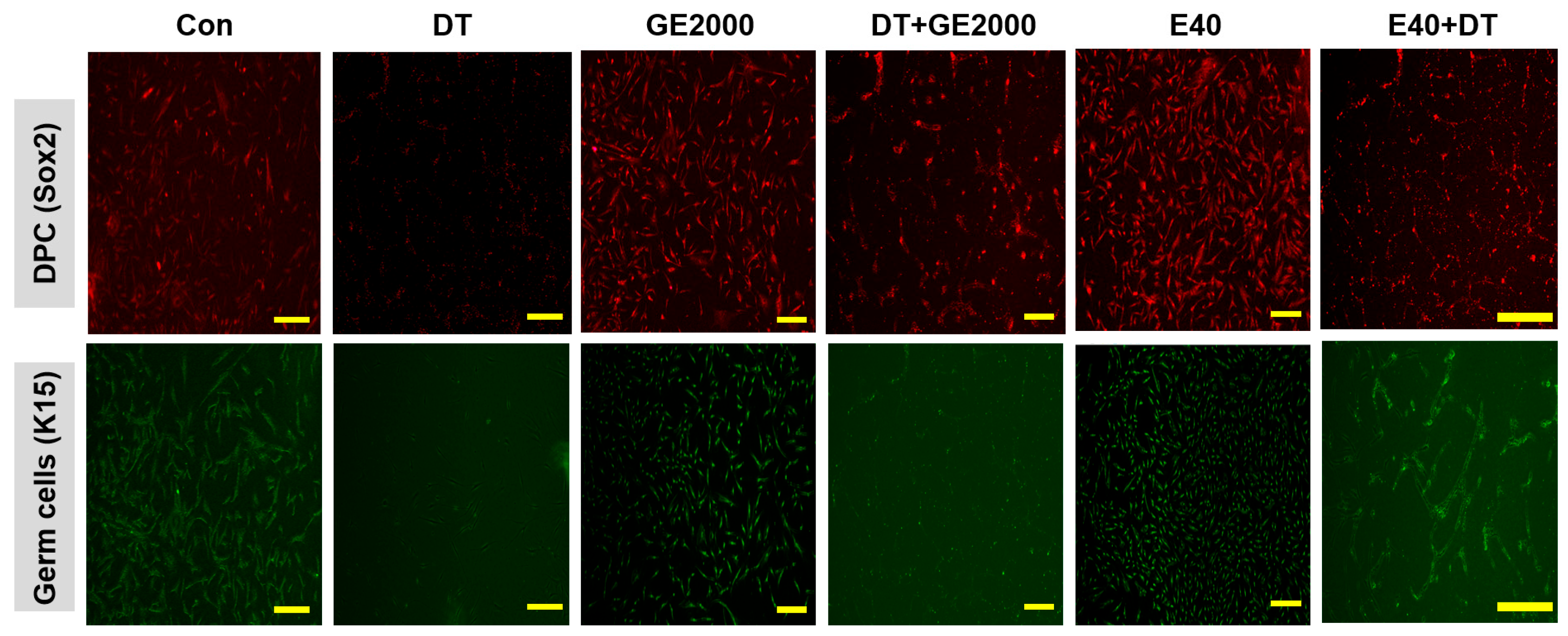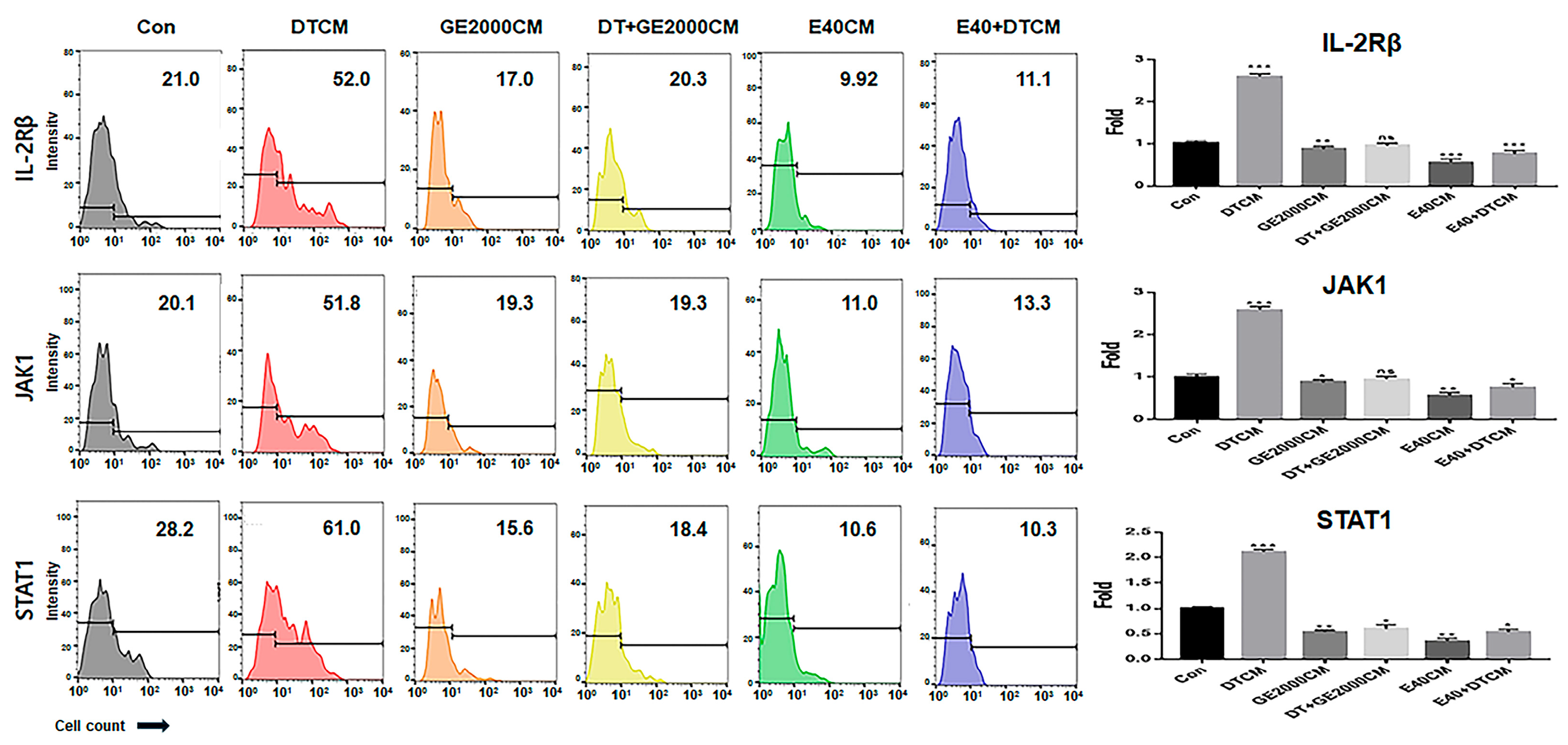Effects of Biomaterials Derived from Germinated Hemp Seeds on Stressed Hair Stem Cells and Immune Cells
Abstract
:1. Introduction
2. Results
2.1. Suppression of Alopecia Markers in HFDPSCs by Two Materials
2.2. Activation and Protection of Differentiation in HFDPSCs by Two Materials
2.3. Prevention of Alopecia by GE2000 and E40 in Immune Cells
2.4. Comparison of Effects of Hemp Seed Oil and Two Materials
3. Discussion
4. Materials and Methods
4.1. Callus Induction and Purification of Exosomes, and Extraction of Germinated Hemp Seeds
4.2. Establishment of Treatment Dosage in Human Follicle Dermal Papilla Stem Cells
4.3. Evaluating Metabolic Modulators of Alopecia
4.4. Evaluating the Differentiating Patterns of HFDPSCs under the Two Materials
4.5. Images of Differentiated HFDPCs and Germ Cells
4.6. Modulation of CD8+ T Cells by the Two Materials
4.7. Concentration of IFNγ in CD8+ T Cells by the Two Materials
5. Conclusions
Supplementary Materials
Author Contributions
Funding
Institutional Review Board Statement
Informed Consent Statement
Data Availability Statement
Conflicts of Interest
References
- Rambwawasvika, H.; Dzomba, P.; Gwatidzo, L. Alopecia types, current and future treatment. J. Dermatol. Cosmetol. 2021, 5, 93–99. [Google Scholar] [CrossRef]
- Lolli, F.; Pallotti, F.; Rossi, A.; Fortuna, M.C.; Caro, G.; Lenzi, A.; Sansone, A.; Lombardo, F. Androgenetic alopecia: A review. Endocrine 2017, 57, 9–17. [Google Scholar] [CrossRef] [PubMed]
- Keum, D.I.; Pi, L.-Q.; Hwang, S.T.; Lee, W.-S. Protective effect of Korean Red Ginseng against chemotherapeutic drug-induced premature catagen development assessed with human hair follicle organ culture model. J. Ginseng Res. 2016, 40, 169–175. [Google Scholar] [CrossRef] [PubMed]
- Orasan, M.S.; Roman, I.I.; Coneac, A.; Muresan, A.; Orasan, R.I. Hair loss and regeneration performed on animal models. Clujul Med. 2016, 89, 327. [Google Scholar] [CrossRef] [PubMed]
- Zouboulis, C.C.; Degitz, K. Androgen action on human skin–from basic research to clinical significance. Exp. Dermatol. 2004, 13, 5–10. [Google Scholar] [CrossRef] [PubMed]
- Stenn, K.; Paus, R.; Dutton, T.; Sarba, B. Glucocorticoid effect on hair growth initiation: A reconsideration. Ski. Pharmacol. Physiol. 1993, 6, 125–134. [Google Scholar] [CrossRef] [PubMed]
- Paus, R.; Cotsarelis, G. The biology of hair follicles. N. Engl. J. Med. 1999, 341, 491–497. [Google Scholar] [CrossRef]
- Reynolds, A.J.; Oliver, R.F.; Jahoda, C.A. Dermal cell populations show variable competence in epidermal cell support: Stimulatory effects of hair papilla cells. J. Cell Sci. 1991, 98, 75–83. [Google Scholar] [CrossRef]
- Hibberts, N.; Howell, A.; Randall, V. Balding hair follicle dermal papilla cells contain higher levels of androgen receptors than those from non-balding scalp. J. Endocrinol. 1998, 156, 59–65. [Google Scholar] [CrossRef]
- Keller, N.M. The legalization of industrial hemp and what it could mean for Indiana’s biofuel industry. Ind. Int’l Comp. L. Rev. 2013, 23, 555. [Google Scholar]
- Johnson, R. Defining hemp: A fact sheet. Congr. Res. Serv. 2019, 44742, 1–12. [Google Scholar]
- Citti, C.; Linciano, P.; Russo, F.; Luongo, L.; Iannotta, M.; Maione, S.; Laganà, A.; Capriotti, A.L.; Forni, F.; Vandelli, M.A. A novel phytocannabinoid isolated from Cannabis sativa L. with an in vivo cannabimimetic activity higher than Δ9-tetrahydrocannabinol: Δ9-Tetrahydrocannabiphorol. Sci. Rep. 2019, 9, 20335. [Google Scholar] [CrossRef]
- Smith, G.L. Hair regrowth with novel hemp extract: A case series. Int. J. Trichol. 2023, 15, 18–24. [Google Scholar] [CrossRef] [PubMed]
- Ajao, A.A.-n.; Sadgrove, N.J. Cosmetopoeia of African Plants in Hair Treatment and Care: Topical Nutrition and the Antidiabetic Connection? Diversity 2024, 16, 96. [Google Scholar] [CrossRef]
- Ikeuchi, M.; Sugimoto, K.; Iwase, A. Plant callus: Mechanisms of induction and repression. Plant Cell 2013, 25, 3159–3173. [Google Scholar] [CrossRef] [PubMed]
- He, B.; Shen, P.; Zheng, H.; Chu, Y.; Guan, J.; Li, L. Effects of different hormones on germination and callus induction of hemp seeds. In IOP Conference Series: Earth and Environmental Science; IOP Publishing: Bristol, UK, 2020; p. 012043. [Google Scholar]
- Gupta, R.; Gupta, S.; Gupta, P.; Nüssler, A.K.; Kumar, A. Establishing the Callus-Based Isolation of Extracellular Vesicles from Cissus quadrangularis and Elucidating Their Role in Osteogenic Differentiation. J. Funct. Biomater. 2023, 14, 540. [Google Scholar] [CrossRef] [PubMed]
- Tkach, M.; Théry, C. Communication by extracellular vesicles: Where we are and where we need to go. Cell 2016, 164, 1226–1232. [Google Scholar] [CrossRef]
- Shen, X.; Song, S.; Chen, N.; Liao, J.; Zeng, L. Stem cell-derived exosomes: A supernova in cosmetic dermatology. J. Cosmet. Dermatol. 2021, 20, 3812–3817. [Google Scholar] [CrossRef] [PubMed]
- Li, M.; Li, S.; Du, C.; Zhang, Y.; Li, Y.; Chu, L.; Han, X.; Galons, H.; Zhang, Y.; Sun, H. Exosomes from different cells: Characteristics, modifications, and therapeutic applications. Eur. J. Med. Chem. 2020, 207, 112784. [Google Scholar] [CrossRef] [PubMed]
- Park, Y.; Lee, K.; Kim, S.W.; Lee, M.W.; Kim, B.; Lee, S.G. Effects of induced exosomes from endometrial cancer cells on tumor activity in the presence of Aurea helianthus extract. Molecules 2021, 26, 2207. [Google Scholar] [CrossRef]
- Ohyama, M.; Kamei, K.; Yuasa, A.; Anderson, P.; Milligan, G.; Sakaki-Yumoto, M. Economic burden of alopecia areata: A study of direct and indirect cost in Japan using real-world data. J. Dermatol. 2023, 50, 1246–1254. [Google Scholar] [CrossRef]
- Nestor, M.S.; Ablon, G.; Gade, A.; Han, H.; Fischer, D.L. Treatment options for androgenetic alopecia: Efficacy, side effects, compliance, financial considerations, and ethics. J. Cosmet. Dermatol. 2021, 20, 3759–3781. [Google Scholar] [CrossRef]
- Farhood, I.G.; Mamoori, A.; Sahib, Z.H. Clinical and pathological evaluation of hemp seeds oil effectiveness in the treatment of alopecia areata. Med. J. Babylon 2023, 20, 108–111. [Google Scholar]
- Gupta, A.K.; Talukder, M.; Bamimore, M.A. Natural products for male androgenetic alopecia. Dermatol. Ther. 2022, 35, e15323. [Google Scholar] [CrossRef]
- Schuster, M.; Bird, R. Legal strategy during legal uncertainty: The case of cannabis regulation. Stan. JL Bus. Fin. 2021, 26, 362. [Google Scholar]
- Crini, G.; Lichtfouse, E.; Chanet, G.; Morin-Crini, N. Traditional and new applications of hemp. In Sustainable Agriculture Reviews 42: Hemp Production and Applications; Springer: Cham, Switzerland, 2020; pp. 37–87. [Google Scholar]
- Cuthrell, K.M.; Jiménez, L.A. Alopecia Areata’s Psychological Impact on Quality of Life, Mental Health, and Work Productivity: A Scoping Review. Int. Neuropsychiatr. Dis. J. 2024, 21, 48–58. [Google Scholar] [CrossRef]
- Wal, P.; Wal, A. CBD: A Potential Lead against Hair Loss, Alopecia, and its Potential Mechanisms. Curr. Drug Discov. Technol. 2024, 21, 86–94. [Google Scholar] [CrossRef]
- Imam, S.S.; Mehdi, S.; Mansuri, A. A Comprehensive Review on the Pharmacological Potential of Red Ginseng Oil, Tea Tree Oil and Hemp Seed Oil. Eur. J. Biomed. 2024, 11, 167–177. [Google Scholar]
- Gupta, A.K.; Talukder, M. Cannabinoids for skin diseases and hair regrowth. J. Cosmet. Dermatol. 2021, 20, 2703. [Google Scholar] [CrossRef]
- Souza, J.D.S.; Fassoni-Ribeiro, M.; Batista, R.M.; Ushirohira, J.M.; Zuardi, A.W.; Guimarães, F.S.; Campos, A.C.; Osório, F.d.L.; Elias, D.; Souza, C.S. Case report: Cannabidiol-induced skin rash: A case series and key recommendations. Front. Pharmacol. 2022, 13, 881617. [Google Scholar] [CrossRef]
- Choi, B.Y. Targeting Wnt/β-catenin pathway for developing therapies for hair loss. Int. J. Mol. Sci. 2020, 21, 4915. [Google Scholar] [CrossRef]
- Wodarz, A.; Nusse, R. Mechanisms of Wnt signaling in development. Annu. Rev. Cell Dev. Biol. 1998, 14, 59–88. [Google Scholar] [CrossRef]
- Daszczuk, P.; Mazurek, P.; Pieczonka, T.D.; Olczak, A.; Boryń, Ł.M.; Kobielak, K. An intrinsic oscillation of gene networks inside hair follicle stem cells: An additional layer that can modulate hair stem cell activities. Front. Cell Dev. Biol. 2020, 8, 595178. [Google Scholar] [CrossRef]
- Nilforoushzadeh, M.A.; Zare, M.; Zarrintaj, P.; Alizadeh, E.; Taghiabadi, E.; Heidari-Kharaji, M.; Amirkhani, M.A.; Saeb, M.R.; Mozafari, M. Engineering the niche for hair regeneration—A critical review. Nanomed. Nanotechnol. Biol. Med. 2019, 15, 70–85. [Google Scholar] [CrossRef]
- Lensing, M.; Jabbari, A. An overview of JAK/STAT pathways and JAK inhibition in alopecia areata. Front. Immunol. 2022, 13, 955035. [Google Scholar] [CrossRef]
- Aloo, S.O.; Kwame, F.O.; Oh, D.-H. Identification of possible bioactive compounds and a comparative study on in vitro biological properties of whole hemp seed and stem. Food Biosci. 2023, 51, 102329. [Google Scholar] [CrossRef]
- Liu, M.; Childs, M.; Loos, M.; Taylor, A.; Smart, L.B.; Abbaspourrad, A. The effects of germination on the composition and functional properties of hemp seed protein isolate. Food Hydrocoll. 2023, 134, 108085. [Google Scholar] [CrossRef]
- Guajardo-Flores, D.; García-Patiño, M.; Serna-Guerrero, D.; Gutiérrez-Uribe, J.; Serna-Saldívar, S. Characterization and quantification of saponins and flavonoids in sprouts, seed coats and cotyledons of germinated black beans. Food Chem. 2012, 134, 1312–1319. [Google Scholar] [CrossRef]
- Huang, D.; Gong, Z.-y.; Liu, S.-c.; Zheng, X.-p.; Kyaw, K.M.; Lin, B.-j. Panax notoginseng saponins promote hair follicle growth in mice via Wnt/β-Catenin signaling pathway. Chem. Biol. Drug Des. 2023, 101, 1416–1424. [Google Scholar] [CrossRef]
- Xiao, T.; Li, B.; Lai, R.; Liu, Z.; Xiong, S.; Li, X.; Zeng, Y.; Jiao, S.; Tang, Y.; Lu, Y. Active pharmaceutical ingredient-ionic liquids assisted follicular co-delivery of ferulic acid and finasteride for enhancing targeted anti-alopecia. Int. J. Pharm. 2023, 648, 123624. [Google Scholar] [CrossRef]







| Num | Target Gene | Sequence |
|---|---|---|
| 1 | Sox2 | F: ATGGACAGTTACGCGCACA |
| R: ATGCTGATCATGTCCCGGAG | ||
| 2 | Itga9 | F: AAGGCCTGTCATTACGGTGG |
| R: GCATCTGGCCCTTCTCCTTT | ||
| 3 | STAT1 | F: TGTTATGGGACCGCACCTTC |
| R: TTGGAGATCACCACAACGGG | ||
| 4 | 5α-reductase type 1 | F: GGCTGAGACCGGTGCG |
| R: GGCTGAGACCGGTGCG | ||
| 5 | P-cadherin | F: GGGAGGCTGAAGTGACCTTG |
| R: TGGAGCAACCACCCAATCTC | ||
| 6 | Wnt | F: TGCCTCACAAGGCATCAGTT |
| R: GGAACCCATCAGGACACTCG | ||
| 7 | TCF | F: GGATGGCTATCCAGACGCTC |
| R: AGTTTGGCACTCCAACTTCG | ||
| 8 | β-catenin | F: GAGCGGACCTACGGACTGTG |
| R: CAGCGAGGTCACTTCCAACA | ||
| 9 | NKG2DL | F: CCTCTGTCACGGCTTTCCTT |
| R: AATCCTTCCCTTGAGCACCG | ||
| 10 | IL-15R | F: CTCGGGTTTCAAGCGGAAGG |
| R: TCGCGGATGCACTTGAGC | ||
| 11 | GAPDH | F: GTGGTCTCCTCTGACTTCAACA |
| R: CTCTTCCTCTTGTGCTCTTGCT | ||
| GAPDH | F: GGATTTGGTCGTATTGGGCG | |
| R: TCCCGTTCTCAGCCATGTAG |
Disclaimer/Publisher’s Note: The statements, opinions and data contained in all publications are solely those of the individual author(s) and contributor(s) and not of MDPI and/or the editor(s). MDPI and/or the editor(s) disclaim responsibility for any injury to people or property resulting from any ideas, methods, instructions or products referred to in the content. |
© 2024 by the authors. Licensee MDPI, Basel, Switzerland. This article is an open access article distributed under the terms and conditions of the Creative Commons Attribution (CC BY) license (https://creativecommons.org/licenses/by/4.0/).
Share and Cite
Kim, D.; Kim, N.P.; Kim, B. Effects of Biomaterials Derived from Germinated Hemp Seeds on Stressed Hair Stem Cells and Immune Cells. Int. J. Mol. Sci. 2024, 25, 7823. https://doi.org/10.3390/ijms25147823
Kim D, Kim NP, Kim B. Effects of Biomaterials Derived from Germinated Hemp Seeds on Stressed Hair Stem Cells and Immune Cells. International Journal of Molecular Sciences. 2024; 25(14):7823. https://doi.org/10.3390/ijms25147823
Chicago/Turabian StyleKim, Donghyun, Namsoo Peter Kim, and Boyong Kim. 2024. "Effects of Biomaterials Derived from Germinated Hemp Seeds on Stressed Hair Stem Cells and Immune Cells" International Journal of Molecular Sciences 25, no. 14: 7823. https://doi.org/10.3390/ijms25147823





